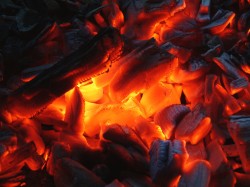At the beginning of human history, mankind made the earth-shattering discovery that the application of heat makes food taste considerably better, and so began one of the longest-standing cultural centerpieces of all time: cooking.
Charcoal Basics
It was only relatively recently in the human timeline that heat came from anywhere other than an open flame fueled by axe-felled firewood. Today, we have the gas and electric oven which domesticate the heat-to-food application, taming it so that cooking can be done indoors. However, the rustic and smoky flavors of food cooked over an open flame will never be domesticated and brought indoors. These are the wild flavors of the outdoors, as free as the nature they are derived from.
At some point in human development, mankind realized that the ideal fuel for a cooking fire would be relatively controllable, with low smoke and minimal flare-up potential. At some length, humans discovered that they could drive away all of the uncontrollable, smoky, flare-up prone elements of firewood by cooking them off ahead of time. After wood has been heated to burning temperatures for several hours and then cooled, what remains is only the burnable elements of wood. This became known as charcoal, the fuel that burns long and hot with minimal smoke and maximal predictability.
Charcoal Types
The first and longest-lasting type of charcoal is lump charcoal. This is, quite simply, wood that has been heated in a kiln to temperatures at which it would normally burn. Heating the wood chunks to this level for several hours causes the wood to shrink as water and other natural impurities are burned off, leaving behind only the carbon structure of the wood.
The second and more common type of charcoal in this modern age is charcoal briquettes. Charcoal briquettes are made in almost the same manner as lump charcoal, except the wood has been ground into sawdust and pressed together into uniform shapes. This sawdust is bound together by a number of chemicals that help it to hold its shape.
Which Type is Better?
Both lump and briquette charcoal perform the task of outdoor cooking superbly. Both light easily, impart great flavor, and burn controllably and predictably. However, most grill masters tend to prefer one over the other. Some maintain staunchly that the purity of lump charcoal clearly makes it superior to the chemical-pumped briquette. Others herald predictability imparted by the geometric shape of the briquette. Both sides can agree on one thing, however: no matter what type of charcoal you choose, it’s better than gas.
Go back to BBQ Accessories Main Page
Go to iGrillBBQ.com Home Page from Charcoal
